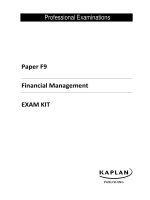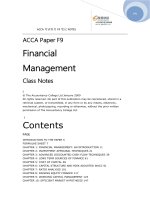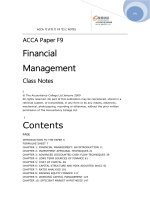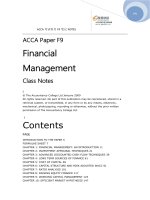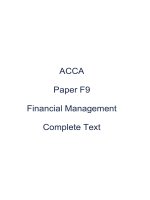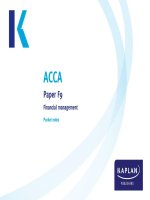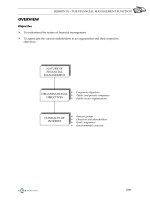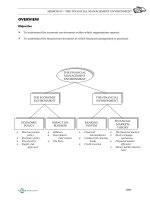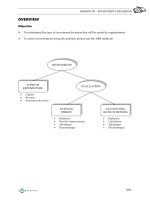ACCA paper f9 financial management
Bạn đang xem bản rút gọn của tài liệu. Xem và tải ngay bản đầy đủ của tài liệu tại đây (1.34 MB, 150 trang )
[年]
ACCA 考试科目 F9 笔记 NOTES
ACCA Paper F9
Financial
Management
Class Notes
2
© The Accountancy College Ltd January 2009
All rights reserved. No part of this publication may be reproduced, stored in a
retrieval system, or transmitted, in any form or by any means, electronic,
mechanical, photocopying, recording or otherwise, without the prior written
permission of The Accountancy College Ltd.
3
Contents
PAGE
INTRODUCTION TO THE PAPER 5
FORMULAE SHEET 7
CHAPTER 1: FINANCIAL MANAGEMENT: AN INTRODUCTION 11
CHAPTER 2: INVESTMENT APPRAISAL TECHNIQUES 21
CHAPTER 3: ADVANCED DISCOUNTED CASH FLOW TECHNIQUES 39
CHAPTER 4: LONG TERM SOURCES OF FINANCE 61
CHAPTER 5: COST OF CAPITAL 69
CHAPTER 6: CAPITAL STRUCTURE AND RISK ADJUSTED WACC 91
CHAPTER 7: RATIO ANALYSIS 101
CHAPTER 8: RAISING EQUITY FINANCE 117
CHAPTER 9: WORKING CAPITAL MANAGEMENT 123
CHAPTER 10: EFFICIENT MARKET HYPOTHESIS 147
[年]
ACCA 考试科目 F9 笔记 NOTES
CHAPTER 11: VALUATION 151
CHAPTER 12: RISK 165
4
INTRODUCTION TO THE PAPER
5
Introduction to the
paper
INTRODUCTION TO THE PAPER
6
AIM OF THE PAPER
The aim of the paper is to develop knowledge and skills expected of a financial
manager, relating to issues affecting investment, financing and dividend policy
decisions.
OUTLINE OF THE SYLLABUS
1. Financial management function
2. Financial management environment
3. Working capital management
4. Investment appraisal
5. Business finance
6. Cost of capital
7. Business valuation
8. Risk management
FORMAT OF THE EXAM PAPER
The syllabus is assessed by a three hour paper-based examination.
The examination consists of 4 questions of 25 marks each. All questions are
compulsory.
FAQs
How does the new syllabus relate to the papers in the
[年]
ACCA 考试科目 F9 笔记 NOTES
previous syllabus?
The paper is materially based on the previous paper, 2.4 FMC, but with additional
material from paper 3.7 SFM. It covers the financial management topics from the
first paper but drops management accounting topics such as Standard Costing,
Budgeting and ABC. To balance against that it now incorporates new topics on Cost
of capital and Valuation.
FORMULAE
7
Formulae
FORMULAE
8
FORMULAE
Economic Order Quantity
=
0
H
2C D
C
Miller-Orr Model
Return point = Lower limit + (1/3 spread)
Spread = 3
1
33
transaction cost variance of cash flows
4
interest rate
The Capital Asset Pricing Model
E(ri) = Rf + ßi (E (rm) – Rf)
The Asset Beta Formula
ßa =
e
e
[年]
ACCA 考试科目 F9 笔记 NOTES
ed
V
(V V (1 T))
+
d
d
ed
V (1 T)
(V V (1 T))
The Growth Model
P0 =
0
e
D (1 g)
(K g)
or P0 =
0
e
D (1 g)
(r g)
Gordon’s Growth Approximation
g = bre
The weighted average cost of capital
WACC =
e
ed
V
VV
ke +
d
ed
V
VV
kd (1–T)
The Fisher formula
(1 + i) = (1 + r)(1 + h)
Purchasing Power Parity and Interest Rate Parity
S 1 = S0 c
b
(1 h )
[年]
ACCA 考试科目 F9 笔记 NOTES
(1 h )
F 0 = S0 c
b
(1 i )
(1 i )
FORMULAE
9
Present Value Table
Present value of 1 i.e. (1 + r)-n
Where r = discount rate
n = number of periods until payment
Discount rate (r)
Periods
(n) 1% 2% 3% 4% 5% 6% 7% 8% 9% 10%
__________________________________________________________________________
______
1 0.990 0.980 0.971 0.962 0.952 0.943 0.935 0.926 0.917 0.909 1
2 0.980 0.961 0.943 0.925 0.907 0.890 0.873 0.857 0.842 0.826 2
3 0.971 0.942 0.915 0.889 0.864 0.840 0.816 0.794 0.772 0.751 3
4 0.961 0.924 0.888 0.855 0.823 0.792 0.763 0.735 0.708 0.683 4
5 0.951 0.906 0.863 0.822 0.784 0.747 0.713 0.681 0.650 0.621 5
6 0.942 0.888 0.837 0.790 0.746 0.705 0.666 0.630 0.596 0.564 6
7 0.933 0.871 0.813 0.760 0.711 0.665 0.623 0.583 0.547 0.513 7
8 0.923 0.853 0.789 0.731 0.677 0.627 0.582 0.540 0.502 0.467 8
9 0.914 0.837 0.766 0.703 0.645 0.592 0.544 0.500 0.460 0.424 9
10 0.905 0.820 0.744 0.676 0.614 0.558 0.508 0.463 0.422 0.386 10
11 0.896 0.804 0.722 0.650 0.585 0.527 0.475 0.429 0.388 0.350 11
12 0.887 0.788 0.701 0.625 0.557 0.497 0.444 0.397 0.356 0.319 12
13 0.879 0.773 0.681 0.601 0.530 0.469 0.415 0.368 0.326 0.290 13
14 0.870 0.758 0.661 0.577 0.505 0.442 0.388 0.340 0.299 0.263 14
15 0.861 0.743 0.642 0.555 0.481 0.417 0.362 0.315 0.275 0.239 15
__________________________________________________________________________
______
(n) 11% 12% 13% 14% 15% 16% 17% 18% 19% 20%
__________________________________________________________________________
______
1 0.901 0.893 0.885 0.877 0.870 0.862 0.855 0.847 0.840 0.833 1
2 0.812 0.797 0.783 0.769 0.756 0.743 0.731 0.718 0.706 0.694 2
[年]
ACCA 考试科目 F9 笔记 NOTES
3 0.731 0.712 0.693 0.675 0.658 0.641 0.624 0.609 0.593 0.579 3
4 0.659 0.636 0.613 0.592 0.572 0.552 0.534 0.516 0.499 0.482 4
5 0.593 0.567 0.543 0.519 0.497 0.476 0.456 0.437 0.419 0.402 5
6 0.535 0.507 0.480 0.456 0.432 0.410 0.390 0.370 0.352 0.335 6
7 0.482 0.452 0.425 0.400 0.376 0.354 0.333 0.314 0.296 0.279 7
8 0.434 0.404 0.376 0.351 0.327 0.305 0.285 0.266 0.249 0.233 8
9 0.391 0.361 0.333 0.308 0.284 0.263 0.243 0.225 0.209 0.194 9
10 0.352 0.322 0.295 0.270 0.247 0.227 0.208 0.191 0.176 0.162 10
11 0.317 0.287 0.261 0.237 0.215 0.195 0.178 0.162 0.148 0.135 11
12 0.286 0.257 0.231 0.208 0.187 0.168 0.152 0.137 0.124 0.112 12
13 0.258 0.229 0.204 0.182 0.163 0.145 0.130 0.116 0.104 0.093 13
14 0.232 0.205 0.181 0.160 0.141 0.125 0.111 0.099 0.088 0.078 14
15 0.209 0.183 0.160 0.140 0.123 0.108 0.095 0.084 0.074 0.065 15
FORMULAE
10
Annuity Table
Present value of an annuity of 1 i.e.
r
1 - (1 + r)-n
Where r = discount rate
n = number of periods
Discount rate (r)
Periods
(n) 1% 2% 3% 4% 5% 6% 7% 8% 9% 10%
__________________________________________________________________________
______
1 0.990 0.980 0.971 0.962 0.952 0.943 0.935 0.926 0.917 0.909 1
2 1.970 1.942 1.913 1.886 1.859 1.833 1.808 1.783 1.759 1.736 2
3 2.941 2.884 2.829 2.775 2.723 2.673 2.624 2.577 2.531 2.487 3
4 3.902 3.808 3.717 3.630 3.546 3.465 3.387 3.312 3.240 3.170 4
5 4.853 4.713 4.580 4.452 4.329 4.212 4.100 3.993 3.890 3.791 5
6 5.795 5.601 5.417 5.242 5.076 4.917 4.767 4.623 4.486 4.355 6
7 6.728 6.472 6.230 6.002 5.786 5.582 5.389 5.206 5.033 4.868 7
8 7.652 7.325 7.020 6.733 6.463 6.210 5.971 5.747 5.535 5.335 8
9 8.566 8.162 7.786 7.435 7.108 6.802 6.515 6.247 5.995 5.759 9
10 9.471 8.983 8.530 8.111 7.722 7.360 7.024 6.710 6.418 6.145 10
11 10.37 9.787 9.253 8.760 8.306 7.887 7.499 7.139 6.805 6.495 11
12 11.26 10.58 9.954 9.385 8.863 8.384 7.943 7.536 7.161 6.814 12
[年]
ACCA 考试科目 F9 笔记 NOTES
13 12.13 11.35 10.63 9.986 9.394 8.853 8.358 7.904 7.487 7.103 13
14 13.00 12.11 11.30 10.56 9.899 9.295 8.745 8.244 7.786 7.367 14
15 13.87 12.85 11.94 11.12 10.38 9.712 9.108 8.559 8.061 7.606 15
__________________________________________________________________________
______
(n) 11% 12% 13% 14% 15% 16% 17% 18% 19% 20%
__________________________________________________________________________
______
1 0.901 0.893 0.885 0.877 0.870 0.862 0.855 0.847 0.840 0.833 1
2 1.713 1.690 1.668 1.647 1.626 1.605 1.585 1.566 1.547 1.528 2
3 2.444 2.402 2.361 2.322 2.283 2.246 2.210 2.174 2.140 2.106 3
4 3.102 3.037 2.974 2.914 2.855 2.798 2.743 2.690 2.639 2.589 4
5 3.696 3.605 3.517 3.433 3.352 3.274 3.199 3.127 3.058 2.991 5
6 4.231 4.111 3.998 3.889 3.784 3.685 3.589 3.498 3.410 3.326 6
7 4.712 4.564 4.423 4.288 4.160 4.039 3.922 3.812 3.706 3.605 7
8 5.146 4.968 4.799 4.639 4.487 4.344 4.207 4.078 3.954 3.837 8
9 5.537 5.328 5.132 4.946 4.772 4.607 4.451 4.303 4.163 4.031 9
10 5.889 5.650 5.426 5.216 5.019 4.833 4.659 4.494 4.339 4.192 10
11 6.207 5.938 5.687 5.453 5.234 5.029 4.836 4.656 4.486 4.327 11
12 6.492 6.194 5.918 5.660 5.421 5.197 4.988 4.793 4.611 4.439 12
13 6.750 6.424 6.122 5.842 5.583 5.342 5.118 4.910 4.715 4.533 13
14 6.982 6.628 6.302 6.002 5.724 5.468 5.229 5.008 4.802 4.611 14
15 7.191 6.811 6.462 6.142 5.847 5.575 5.324 5.092 4.876 4.675 15
CHAPTER 1 – FINANCIAL MANAGEMENT: AN INTRODUCTION
11
Chapter 1
Financial
management: an
intorduction
CHAPTER 1 – FINANCIAL MANAGEMENT: AN INTRODUCTION
[年]
ACCA 考试科目 F9 笔记 NOTES
12
CHAPTER CONTENTS
WHAT IS FINANCIAL MANAGEMENT? --------------------------------- 13
THE THREE KEY DECISIONS 13
CORPORATE STRATEGY AND FINANCIAL MANAGEMENT 15
FINANCIAL OBJECTIVES 15
VALUE FOR MONEY 16
STAKEHOLDERS 17
CHAPTER 1 – FINANCIAL MANAGEMENT: AN INTRODUCTION
13
WHAT IS FINANCIAL MANAGEMENT?
May be considered as:
The management of all matters associated with the cash flow of the organisation
both short and long-term.
Financial management and the accounting equation
The three key decisions
Financial management is often described in terms of the three basic decisions to be
made:
● the investment decision,
● the financial decision,
● the dividend decision.
Each of these decisions have to be looked at in far greater detail later on in the
course but as an outline these are the basic considerations:
1. The investment decision
A company may invest its funds in one of three basic areas:
1. Capital assets
2. Working capital
3. Financial assets
Non Current
Assets
Working
[年]
ACCA 考试科目 F9 笔记 NOTES
Capital
Debt and
Equity
+=
Sourcing
of funds
Application
of funds
CHAPTER 1 – FINANCIAL MANAGEMENT: AN INTRODUCTION
14
Capital assets
A critical decision because of the strategic implications of many investments, the
decision would include the following financial considerations:
1. Return
2. Risk
3. Cash flow
4. Profit.
Working capital
The cash resource available to the business on a day-to-day basis and used to fund
the current assets such as inventory and receivables. The key to identifying the
level of investment is to balance the risk of insolvency against the cost of funding.
Financial assets
Not a core area of the course, we tend to focus on financing from the perspective of
a company rather than the investor. This being the case the only financial
investment to consider is short-term saving. In this circumstance then the key
considerations are, in order:
1. Risk
2. Liquidity
[年]
ACCA 考试科目 F9 笔记 NOTES
3. Return.
2. The financing decision
When looking at the financing of a business there are 4 basic questions to consider:
1. total funding required,
2. internally generated vs externally sourced,
3. debt or equity,
4. long-term or short-term debt.
Total funding required
The funding requirement will be determined by an assessment of the following
Application of funds Source of funds
Existing asset base Existing funding
New assets Redemption of existing debt
Disposals Funds generated through trading
Change in Working Capital
CHAPTER 1 – FINANCIAL MANAGEMENT: AN INTRODUCTION
15
Internally vs externally generated funds
A company may be able to fund business growth via internally generated funds
such as retained earnings. If those funds are limited or the company wishes to
grow at a faster rate then external sources of funding must be tapped.
Debt vs equity
The gearing decision which forms the basis of two later chapters. A critical issue in
terms of risk and cost of funding.
Short-term vs long-term debt
A consideration focussed upon in the funding of working capital, short-term funding
may have benefits of flexibility and lower cost but is inherently risky.
3. The dividend decision
The amount of return to be paid in cash to shareholders. This is a critical measure
of the companies ability to pay a cash return to its shareholders. The level of
dividend paid will be determined by the following:
1. Profitability
2. Cash flow
3. Growth
[年]
ACCA 考试科目 F9 笔记 NOTES
4. Legal restrictions
5. Shareholder expectations.
Corporate strategy and financial management
The role of the financial manager is to align the aims of financial management team
with those of the wider corporate strategy. The strategy of the business may be
separated into corporate, business and operational objectives. Financial managers
should be attempting to fulfil those objectives.
The nature of financial management means that it is fundamental to the translation
of strategic aims into financial transactions.
Financial objectives
Financial objectives of commercial companies may include:
1. Maximising shareholders‟ wealth
2. Maximising profits
3. Satisficing.
1. Maximising shareholders’ wealth
A fundamental aim within financial management is to create and sustain
shareholders‟ wealth. Wealth being the ongoing value of shares of the
organisation. The importance of this concept is that there is no time period to the
wealth and that it is determined by the relative risk/ return balance of the business.
All aspects of financial management are based on this basic premise.
CHAPTER 1 – FINANCIAL MANAGEMENT: AN INTRODUCTION
16
2. Maximising profits
Within organisations it is normal to reward management on some measure of profit
such as ROI or RI. In simple terms we would expect a close relationship between
profit and shareholders‟ wealth. There are, however, ways in which they may
conflict such as:
1. Short-termism.
2. Cash vs accruals.
3. Risk.
Short-termism
A profit target is normally calculated over one year, it is relatively easy to
manipulate profit over that period to enhance rewards at the expense of future
years.
[年]
ACCA 考试科目 F9 笔记 NOTES
Cash vs accruals
As we will see later, wealth is calculated on a cash basis and ignores accruals.
Risk
A manager may be inclined to accept very risky projects in order to achieve profit
targets which in turn would adversely affect the value of the business.
3. Satisficing
Many organisations do not profit maximise but instead aim to satisfice. This means
that they attempt to generate an acceptable level of profit with a minimum of risk.
It reflects the fact that many organisations are more concerned with surviving than
growth.
4. Objectives of not-for-profit organisations
These organisations are established to pursue non-financial aims but are to provide
services to the community. Such organisations like profit-seeking companies need
funds to finance their operations. Their major constraint is the amount of funds
that they would be able to raise. As a result not-for-profit organisations should
seek to use the limited funds so as to obtain value for money.
Value for money
Value for money means providing a service in a way, which is economical, efficient
and effective. It simply means that getting the best possible service at the least
possible cost. Public services for example are funded by the taxpayers and in
seeking value for money; the needs of the taxpayer are being served, insofar as
resources are being used in the best manner to provide essential services.
CHAPTER 1 – FINANCIAL MANAGEMENT: AN INTRODUCTION
17
Economy measures the cost of obtaining the required quality inputs needed to
produce the service. The aim is to acquire the necessary input at the lowest
possible cost.
Effectiveness means doing the right thing. It measures the extent to which the
service meets its declared objectives.
Efficiency means doing the right thing well. It relates to the level of output
generated by a given input. Reducing the input: output ratio is an indication of
increased efficiency.
Example ---- in refuse collection service,
The service will be economic if it is able to minimise the cost of weekly collection
[年]
ACCA 考试科目 F9 笔记 NOTES
and not suffer from wasted use of resources.
The service will be effective if it meet it target of weekly collection.
The service will be efficient if it is able to raise the number of collection per vehicle
per week.
Stakeholders
We tend to focus on the shareholder as the owner and key stakeholder in a
business. A more comprehensive view would be to consider a wider range of
interested parties or stakeholders.
Stakeholders are any party that has both an interest in and relationship with the
company. The basic argument is that the responsibility of an organisation is to
balance the requirements of all stakeholder groups in relation to the relative
economic power of each group.
Group task
Required:
Identify as many stakeholder groups as you can for a commercial organisation.
VALUE FOR
MONEY
ECONOMY EFFECTIVENESS EFFICIENCY
CHAPTER 1 – FINANCIAL MANAGEMENT: AN INTRODUCTION
18
Conflict between stakeholder groups
The very nature of looking at stakeholders is that the level of „return‟ is finite within
an organisation. There is a need to balance the needs of all groups in relation to
their relative strength.
Group task
Required:
Using the stakeholder groups already identified suggest 5 possible conflicts of
interest that need to be considered.
Agency theory
Agency relationships occur when one or more people employ one or more persons
as agent. The persons who employ others are the principals and those who work
for them are called the agent
In an agency situation, the principal delegate some decision-making powers to the
agent whose decisions affect both parties. This type of relationship is common in
[年]
ACCA 考试科目 F9 笔记 NOTES
business life. For example shareholders of a company delegate stewardship
function to the directors of that company. The reasons why an agents are
employed will vary but the generally an agent may be employed because of the
special skills offered, or information the agent possess or to release the principal
from the time committed to the business.
Goal Congruence
Goal congruence is defined as the state which leads individuals or groups to take
actions which are in their self interest and also in the best interest of the entity.
For an organisation to function properly, it is essential to achieve goal congruence
at all level. All the components of the organisation should have the same overall
objectives, and act cohesively in pursuit of those objectives.
In order to achieve goal congruence, there should be introduction of a careful
designed remuneration packages for managers and the workforce which would
Principal
Agent
CHAPTER 1 – FINANCIAL MANAGEMENT: AN INTRODUCTION
19
motivate them to take decisions which will be consistent with the objectives of the
shareholders.
Money as a prime motivator
The most direct use of money as a motivator is payment by results schemes
whereby an employee‟s pay is directly linked to his results. However, research has
shown that money is not a single motivator or even the prime motivator.
Question
Identify 5 key areas of conflict between directors and shareholders and suggest
what can be done to encourage goal congruence between the two parties.
CHAPTER 1 – FINANCIAL MANAGEMENT: AN INTRODUCTION
20
CHAPTER 2 – INVESTMENT APPRAISAL TECHNIQUES
21
[年]
ACCA 考试科目 F9 笔记 NOTES
Chapter 2
Investment appraisal
techniques
SYLLABUS CONTENT
● Payback
● ARR
● Time value of money
● Discounted cash flow
● NPV
● IRR
● Annuities
● Perpetuities
CHAPTER 2 – INVESTMENT APPRAISAL TECHNIQUES
22
CHAPTER CONTENT DIAGRAM
Payback
Accounting rate of
return (ARR)
Net present value
(NPV)
Internal rate of return
(IRR)
Annuities
Perpetuities
Investment
Appraisal
techniques
[年]
ACCA 考试科目 F9 笔记 NOTES
Basic techniques DCF techniques
CHAPTER 2 – INVESTMENT APPRAISAL TECHNIQUES
23
CHAPTER CONTENTS
INVESTMENT APPRAISAL AND CAPITAL BUDGETING --------------- 24
PAYBACK 25
RETURN ON CAPITAL EMPLOYED (ROCE) 28
DISCOUNTED CASH FLOW ---------------------------------------------- 32
DISCOUNTING 33
NET PRESENT VALUE (NPV) 34
INTERNAL RATE OF RETURN (IRR) 35
NPV AND IRR COMPARED 37
ANNUITIES 37
PERPETUITIES 38
CHAPTER 2 – INVESTMENT APPRAISAL TECHNIQUES
24
INVESTMENT APPRAISAL AND CAPITAL BUDGETING
A form of decision-making where the investment occurs predominantly today and
the benefits of the investment occur in the future. Investment appraisal is of
particular importance because of the following:
1. Long-term
2. Size (in relation to the business)
3. Outflow today (relatively certain), inflow in the future (uncertain).
There are 4 basic methods to be mastered
1. Payback
2. Return on Capital Employed (ROCE)
3. Net present value (NPV)
4. Internal rate of return (IRR).
We shall use the following example to illustrate how each method is calculated.
Example 1 – Reina Ltd
Reina Ltd has the opportunity to invest in two mutually exclusive investments with
the following initial costs and returns:
[年]
ACCA 考试科目 F9 笔记 NOTES
A
(£000s)
Initial investment (100)
Cash flows Yr 1 50
Yr 2 40
Yr 3 30
Yr 4 25
Yr 5 20
Residual value Yr 5 5
The cost of capital is 10%.
Required:
Should the project be accepted?
CHAPTER 2 – INVESTMENT APPRAISAL TECHNIQUES
25
Payback
The length of time it takes for cash inflows from trading to pay back the initial
investment.
Example 2
A
Initial
investment
Periodic Cumulative
Net cash
flows (£)
Yr 1
Yr 2
Yr 3
Yr 4
Alternate computation with equal cash flows each year.
[年]
ACCA 考试科目 F9 笔记 NOTES
Example 3 – Finnan Ltd
Net cash inflow per annum $25,000
Investment $60,000
Required
Payback period
Decision criteria
Accept the project in the event that the time period is within the
acceptable time period. What is an acceptable time period? It depends!!
CHAPTER 2 – INVESTMENT APPRAISAL TECHNIQUES
26
Advantages
1. It is simple to use (calculate) and easy to understand
2. It is a particularly useful approach for ranking projects where a company
faces liquidity constraints and requires a fast repayment of investment.
3. It is appropriate in situations where risky investments are made in uncertain
market that are subject to fast design and product changes or where future
cash flows are particularly difficult to predict.
4. The method is often used in conjunction with the NPV or IRR method and act
as the first screening device to identify projects which are worthy of further
investigation.
5. It provides an important summary method, how quickly will the initial
investment be recouped.
6. Unlike the other traditional methods payback uses cash flows, rather than
accounting profits, and so is less likely to produce an unduly optimistic figure
distorted by assorted accounting conventions.
7. It may be used in selecting projects under capital rationing situation in order
to provide capital for further investments.
8. Rapid payback minimises risk.
Disadvantages
1. It is simple to use (calculate) and easy to understand
2. It is a particularly useful approach for ranking projects where a company
faces liquidity constraints and requires a fast repayment of investment.
[年]
ACCA 考试科目 F9 笔记 NOTES
3. It is appropriate in situations where risky investments are made in uncertain
market that are subject to fast design and product changes or where future
cash flows are particularly difficult to predict.
4. The method is often used in conjunction with the NPV or IRR method and act
as the first screening device to identify projects which are worthy of further
investigation.
5. It provides an important summary method, how quickly will the initial
investment be recouped.
6. Unlike the other traditional methods payback uses cash flows, rather than
accounting profits, and so is less likely to produce an unduly optimistic figure
distorted by assorted accounting conventions.
7. It may be used in selecting projects under capital rationing situation in order
to provide capital for further investments.
8. Rapid payback minimises risk.
CHAPTER 2 – INVESTMENT APPRAISAL TECHNIQUES
27
Example 4 – Chromex (exam standard question)
Chromex plc manufactures bicycles for the UK and European markets, and has
made a bid of £150 million to take over Bexell plc, their main UK competitor, which
is also active in the German market. Chromex currently supplies 24 per cent of the
UK market and Bexell has a 10 per cent share of the same market.
Chromex anticipates labour savings of £700,000 per year, created by more efficient
production and distribution facilities, if the takeover is completed. In addition, the
company intends to sell off surplus land and buildings with a balance sheet value of
£15 million, acquired in the course of the takeover.
Total UK bicycle sales for 20X7 were £400 million. For the year ended 31
December 20X7, Bexell reported an operating profit of £10 million, compared with
a
figure of £55 million for Chromex. In calculating profits, Bexell included a
depreciation charge of £0.5 million.
Note. The takeover is regarded by Chromex in the same way as any other
investment, and is appraised accordingly.
Required
(a) Assuming that the bid is accepted by Bexell, calculate the payback period
(pre-tax) for the investment, if the land and buildings are immediately sold for
£5 million less than the balance sheet valuation, and Bexell‟s sales figures
[年]
ACCA 考试科目 F9 笔记 NOTES
remain static. (3 marks)
(b) Chromex has also appraised the investment in Bexell by calculating the
present value of the company‟s future expected cashflows. What additional
information to that required in (a) would have been necessary? (5 marks)
(Total: 8 marks)
CHAPTER 2 – INVESTMENT APPRAISAL TECHNIQUES
28
Return on capital employed (ROCE)
A measure that considers the impact of the investment on accounting profit. It is
similar in concept to the ROCE performance measure, but is not the same.
Investment appraisal Performance
appraisal
Time period
Over the life of the project A single year
When?
Future Past
Use Decision making Appraisal and reward
structures
ROCE = Estimated Average Annual Profit 100
Average Investment
A
Average annual profit
Net cash flows (less depn)
number of years
= average profit
Average investment
[年]
ACCA 考试科目 F9 笔记 NOTES
Initial investment
Plus residual value
2
Equals ave. investment
ARR
CHAPTER 2 – INVESTMENT APPRAISAL TECHNIQUES
29
Decision criteria
A profit measure that must be compared to a target profit. This profit is likely to be
related to the target performance measure already discussed
Advantages
1. It is easy to understand and easy to calculate.
2. The impact of the project on a company‟s financial statement can also be
specified
3. ROCE is still the commonest way in which business unit performance is
measured and evaluated, and is certainly the most visible to shareholders
4. Managers may be happy in expressing project attractiveness in the same
terms in which their performance will be reported to shareholders, and
according to which they will be evaluated and rewarded.
5. The continuing use of the ARR method can be explained largely by its
utilisation of balance sheet and P&L account magnitudes familiar to managers,
namely profit and capital employed.
Disadvantages
1. It fails to take account of the project life or the timing of cash flows and time
value of money within that life
2. It uses accounting profit, hence subject to various accounting conventions.
3. There is no definite investment signal. The decision to invest or not remains
subjective in view of the lack of objectively set target ARR.
4. Like all rate of return measures, it is not a measurement of absolute gain in
wealth for the business owners.
5. The ARR can be expressed in a variety of ways and is therefore susceptible to
manipulation.
CHAPTER 2 – INVESTMENT APPRAISAL TECHNIQUES
[年]
ACCA 考试科目 F9 笔记 NOTES
30
Example 5 – Armcliff (exam standard question)
Armcliff Limited is a division of Sherin plc which requires each of its divisions to
achieve a rate of return on capital employed of at least 10 per cent per annum. For
this purpose, capital employed is defined as fixed capital and investment in stocks.
This rate of return is also applied as a hurdle rate for new investment projects.
Divisions have limited borrowing powers and all capital projects are centrally
funded.
The following is an extract from Armcliff‟s divisional accounts.
Profit and loss account for the year ended 31 December 20X4
£m
Turnover 120
Cost of sales (100)
____
Operating profit 20
====
Assets employed as at 31 December
20X4
£m £m
Fixed assets (net) 75
Current assets (including stocks £25m) 45
Current liabilities (32)
___
13
___
Net capital employed 88
===
Armcliff‟s production engineers wish to invest in a new computer-controlled press.
The equipment cost is £14 million. The residual value is expected to be £2 million
after four years operation, when the equipment will be shipped to a customer in
South America.
The new machine is capable of improving the quality of the existing product and
also of producing a higher volume. The firm‟s marketing team is confident of
selling the increased volume by extending the credit period. The expected
additional sales are as follows.
Year 1 2,000,000 units
Year 2 1,800,000 units
Year 3 1,600,000 units
Year 4 1,600,000 units
[年]
ACCA 考试科目 F9 笔记 NOTES
Sales volume is expected to fall over time because of emerging competitive
pressures. Competition will also necessitate a reduction in price by £0.5 each year
from the £5 per unit proposed in the first year. Operating costs are expected to be
steady at £1 per unit, and allocation of overheads (none of which are affected by
the new project) by the central finance department is set at £0.75 per unit.
Higher production levels will require additional investment in stocks of £0.5 million,
which would be held at this level until the final stages of operation of the project.
Customers at present settle accounts after 90 days on average.
CHAPTER 2 – INVESTMENT APPRAISAL TECHNIQUES
31
Required
(a) Determine whether the proposed capital investment is attractive to Armcliff,
using the average rate of return on capital method, defined as average profit
to average capital employed, ignoring debtors and creditors. (7 marks)
Note. Ignore taxes.
(b) (i) Suggest three problems which arise with the use of the average return
method for appraising new investment. (3 marks)
(ii) In view of the problems associated with the ARR method, why do
companies continue to use it in project appraisal? (3 marks)
(c) Briefly discuss the dangers of offering more generous credit, and suggest
ways of assessing customers‟ creditworthiness. (7 marks)
(Total: 20 marks)
CHAPTER 2 – INVESTMENT APPRAISAL TECHNIQUES
32
DISCOUNTED CASH FLOW
The application of the idea that there is a TIME VALUE OF MONEY. What this
means is that money received today will have more worth than the same amount
received at some point in the future.
Why would you rather have £100 now rather than in one year‟s time?
[年]
ACCA 考试科目 F9 笔记 NOTES
Reasons 1
2
3
Reminder - compound interest
Example 5
If we invest £100 now (Yr. 0) what will the value of that investment be in 1,2,3,4
years at a compound rate of 10%?
Present Value Calculation Future Value
1 £100
2
3
4
Year 0 Year 1
CHAPTER 2 – INVESTMENT APPRAISAL TECHNIQUES
33
Therefore we are able to express Present Values in terms of Future Values using the
following formula:
FV = PV (1 + r)n
Where PV - Present value.
FV - Future value.
r - Rate of interest or cost of capital.
n - Number of periods (years)
Discounting
The opposite of compounding, where we have the future value (eg an expected
cash inflow in a future year) and we wish to consider its value in present value
terms.
[年]
ACCA 考试科目 F9 笔记 NOTES
Illustration
COMPOUNDING
Year 0 Year 1
DISCOUNTING
Revising the formula
1
PV = FV (1 + r)n = FV (1 + r)-n
Use tables to calculate the present values of the example on the previous page.
Year Future Value Discount factor (from tables) Present Value
£ at 10% £
1 110
2 121
3 133.1
4 146.41
CHAPTER 2 – INVESTMENT APPRAISAL TECHNIQUES
34
Net present value (NPV)
The key investment appraisal method, it incorporates the time value of money in
calculating an absolute value of the project. It is called the NET present value
because there will be a range of outflows and inflows in the typical investment.
Decision criteria
If the investment has a positive NPV then the project should be accepted (negative
rejected). A positive NPV means that the project will increase the wealth of the
company by the amount of the NPV at the current cost of capital.
Example – Reina

